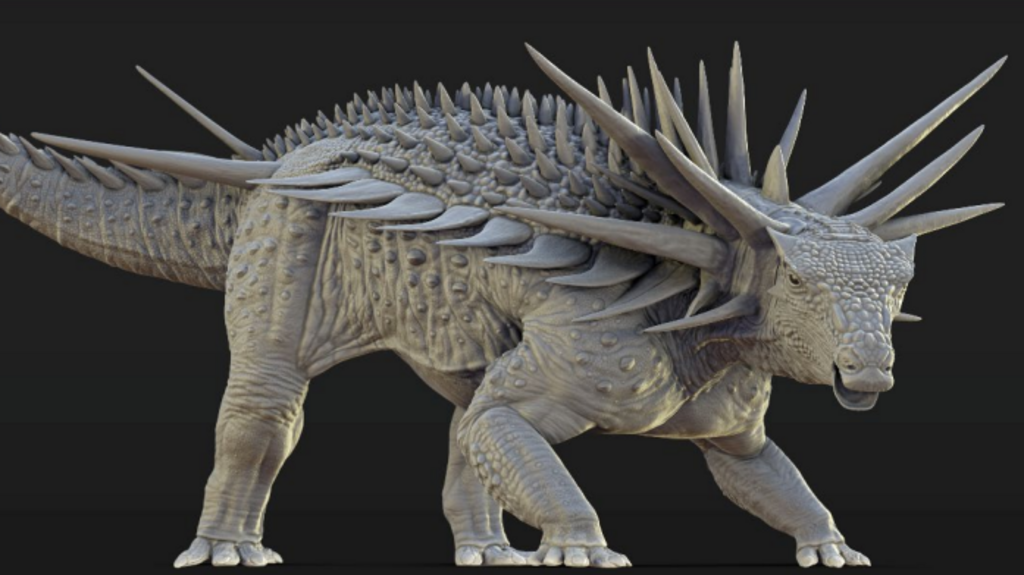Scientists have announced the discovery of an unusual armored dinosaur characterized by meter-long spikes protruding from its neck.
The species, named Spicomellus afer, lived approximately 165 million years ago and represents the oldest known example of ankylosaurs, a group of armored dinosaurs.
Experts have expressed surprise at the complexity and spikiness of the specimen, unearthed in Morocco, prompting a re-evaluation of the evolutionary history of these armored dinosaurs.
Prof. Richard Butler from the University of Birmingham, who co-led the research, described the find to BBC News as the “punk rocker” of its era, referencing the subculture and music style known for its rebellious aesthetic that emerged in the 1970s.
“It is one of the strangest dinosaurs ever discovered,” Prof. Butler stated.
Prof. Susannah Maidment of the Natural History Museum, the project’s co-leader, highlighted the unusual fusion of the spikes directly onto the bone.
“We don’t see that in any other animal, living or extinct,” she noted.
“It’s absolutely covered in really weird spikes and protrusions all over the back of the animal, including a bony collar that wraps around its neck and some sort of weapon on the end of its tail, so a most unusual dinosaur,” she elaborated.
The uniqueness of the discovery has led the researchers to consider a potential revision of existing theories on ankylosaur evolution.
Ankylosaurs persisted until the late Cretaceous period, spanning from 145 to 66 million years ago.
It was previously hypothesized that ankylosaurs initially possessed simple, small armored plates that gradually evolved into larger, more extensive structures as a defense against large carnivorous predators like the Tyrannosaurus Rex, according to Prof. Butler.
“If you had asked me what I would have expected the oldest known ankylosaur to look like I would have said something with quite simple armour,” he told BBC News.
“Instead, we have an animal bristling with spikes like a hedgehog, the most bizarre armour that we’ve ever found in any animal, far outside the range of armour seen in later ankylosaurs.”
While the researchers lack a complete skeleton, estimations suggest the animal measured approximately four meters in length and one meter in height, with a weight of around two tonnes.
The discovery suggests that ankylosaurs may have initially developed elaborate armor during the Jurassic period, which subsequently evolved over millions of years into simpler, potentially more functional forms, according to Prof. Maidment.
“What we are speculating is that maybe these structures actually were used for display, and it was only later in the Cretaceous, when we start to see gigantic dinosaurs with huge jaws and crushing bites, that they actually then needed to co-opt these display structures as body armour.”
The find was made by a local farmer in Boulemane, Morocco, marking the first ankylosaur discovery on the African continent. Prof. Butler recounted his initial reaction upon seeing the fossils.
“it was a jaw dropping, spine-tingling moment, perhaps the most exciting in my career. It was clear right away that this animal was much weirder than we imagined and that we had enough of it to make sense of it,” he said.
Prof. Driss Ouarhache, who led the Moroccan team from the Université Sidi Mohamed Ben Abdellah, stated: “This study is helping to drive forward Moroccan science. We’ve never seen dinosaurs like this before, and there’s still a lot more this region has to offer.”
The research has been published in the journal Nature.
Watch the story of the dig with the Natural History Museum
The Starship rocket is critical to the company’s hopes of one day carrying people to the Moon and Mars.
The photo taken by Bidyut Kalita, is among several highly commended in this year’s Wildlife Photographer of the Year.
Giraffes have always been thought to be one species, but scientists now say there are four.
The YouTuber and former Nasa engineer is working with Jimmy Kimmel to make a new competition show.
We rely on honeybees to pollinate our crops and a new food could protect them from growing threats.

